Mouse is a common name for many small, long-tailed animals with furry bodies. Mice are mammals, animals that feed their young on the mothers’ milk. They belong to a group of mammals called rodents. Animals commonly known as mice include small rats, hamsters, gerbils, voles, harvest mice, and grasshopper mice. All have chisellike incisors (front teeth) that are kept sharp by chewing food. These teeth grow throughout a mouse’s life, enabling it to chew seeds and other tough foods.
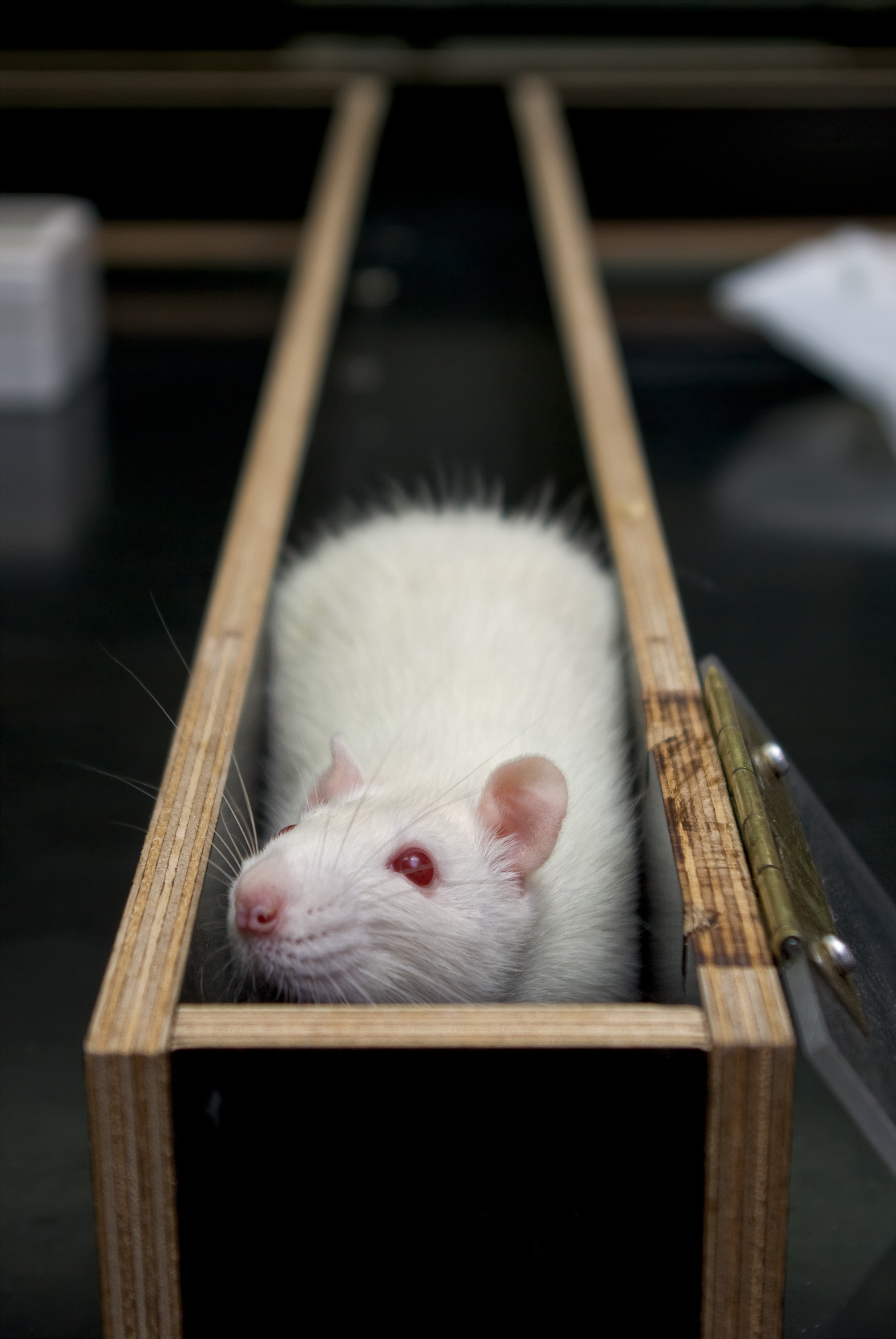
Mice inhabit most parts of the world. They live in mountains, fields, woodlands, deserts, and swamps. Many species (kinds) become active only at night. In the dark, mice can more easily protect themselves against predators (hunting animals). Animals that eat mice include snakes, owls, hawks, cats, and foxes.
The best known kind of mouse is the house mouse. It lives with and near human beings worldwide, often building its nest in homes, garages, or barns. House mice sometimes become pests, damaging people’s homes and crops and spreading diseases. However, mice also have proved helpful to human beings. Scientists have bred white mice from wild house mice for use in important scientific research. People also raise mice as pets.
House mice
Wild house mice lived in the homes of people during ancient times. They took people’s food, just as mice do today. The word mouse comes from an old Sanskrit word meaning thief. Sanskrit is an ancient language of Asia, where house mice originated. People domesticated (tamed) cats largely to control house mice. However, mice eventually spread from Asia throughout Europe. People then accidentally carried them on ships to most other parts of the world.
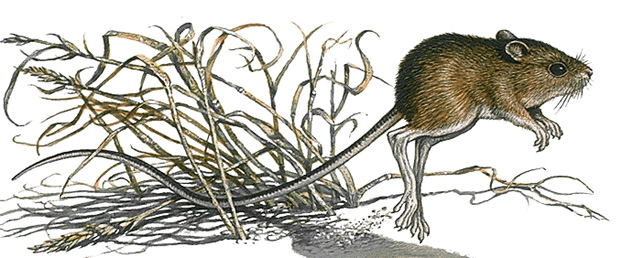
House mice can run quickly and can climb and swim well. They usually come out only at night, though indoors they also may scurry about in the day. People often hear them running within the open walls of houses.
A wild house mouse usually measures from 21/2 to 31/2 inches (6 to 9 centimeters) long without the tail. The tail grows about the same length as the body. Most house mice weigh 1/2 to 1 ounce (14 to 28 grams). Their soft fur has grayish-brown coloring on the back and sides, and light gray or yellowish-white coloring underneath. Scaly skin covers the nearly hairless tail.
The head of a house mouse has rounded ears, black eyes, and a long, narrow snout. Several long, thin whiskers grow from the sides of the snout. These whiskers help the mouse feel its way in the dark and judge the size of holes for hiding. House mice also have good eyesight for night activity. Their strong, sharp front teeth enable them to eat tough seeds and hard-bodied insects. They also can tear apart packages to get at food inside.
Food.
House mice that live outdoors eat seeds, insects, and the leaves, roots, and stems of plants. Indoors, they eat almost anything that people eat. They consume such household items as bread, cereal, crackers, and pet food. Mice can chew into food bags and damage much more food than they eat.
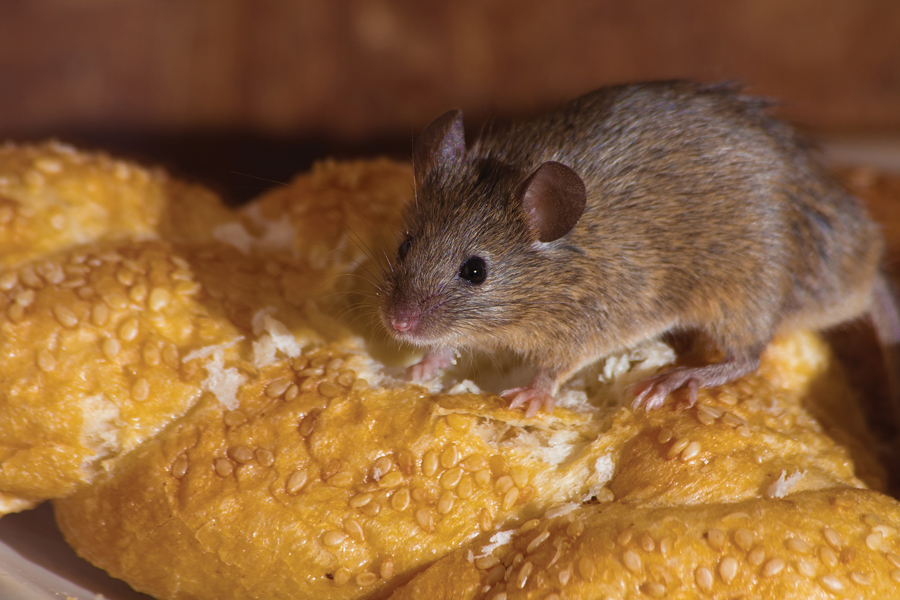
Homes.
House mice live wherever they can find a dark, warm, quiet place with food nearby. Outdoors, the mice dig shallow burrows underground, in which they build grass nests. They may line the nests with dried grass, feathers, or pieces of fur. Indoors, the mice may nest under equipment in a barn, in a warm corner of a garage, or inside a box or drawer in an attic or basement. Abandoned buildings make especially suitable homes for mice. To line their nests, mice may tear strips of paper or clothing or even steal feathers from pillows.
Young.
A female house mouse may have 5 to 10 litters each year, sometimes giving birth to a new litter every 20 to 30 days. Most litters consist of five or six young. Newborn mice have pink skin and no fur, and their eyes are closed. They begin life completely helpless and rely on their mother for milk. Soft fur covers their bodies by the time they are 10 days old. At 14 days, their eyes open. Young mice stay near the nest for about three weeks. They then leave to build their own nests and reproduce.
Enemies.
People rank as the worst enemies of wild house mice. They set traps and place poisons where the mice can easily find them. Numerous meat-eating animals feed on house mice. Cats hunt them in barns and around farmyards. Coyotes, snakes, and other animals capture them in wooded areas. Such birds of prey as owls and hawks swoop down on them in fields and prairies. Wild house mice have so many predators that few survive more than a year in the wild.
House mice avoid their enemies by hiding, coming out at night to feed, and seldom wandering far from the nest. They spend most of their time within an area of about 200 feet (60 meters) in diameter. Where possible, a mouse moves along paths protected by furniture, boxes, or other objects. When it must travel across open spaces between the objects, it runs as fast as it can.
House mice and people.
Many people consider house mice to be pests. They damage furniture and woodwork in houses and occasionally destroy farmers’ crops. House mice can also spread certain diseases, including bubonic plague and typhus.
Loading the player...House mouse
Yet mice rank among the most important animals to human beings. Scientists bred the white mouse from the wild house mouse for use in research laboratories. Over the years, carefully planned experiments with white mice have helped scientists learn how disease affects people and other mammals, how drugs work, and how the brain and other body organs operate.
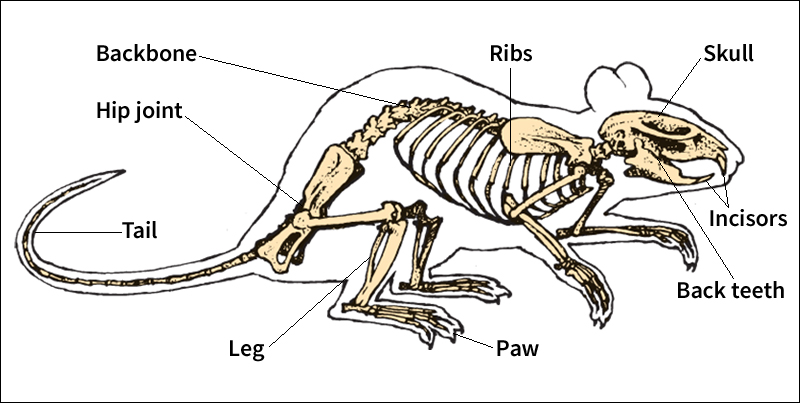
House mice also serve as popular household pets. Some pet owners prefer albino white mice with pink eyes, feet, and tails. However, most white mice are not true albinos and have normal black eyes and dark feet and tails. Pet house mice also come in a variety of other colors or color combinations. Some of the most popular types have black or brown spots. Pet mice and laboratory mice usually live about two years, but some may live as long as six years.
Some other kinds of mice
White-footed mice,
also called deer mice, look somewhat like house mice. But they grow bigger and have larger eyes and ears, white feet, and furry tails. They measure 23/4 to 61/2 inches (7 to 17 centimeters) long without the tail. Young white-footed mice have gray fur above and white fur on the belly. The gray changes to brown or gray-brown when the mice become adults.
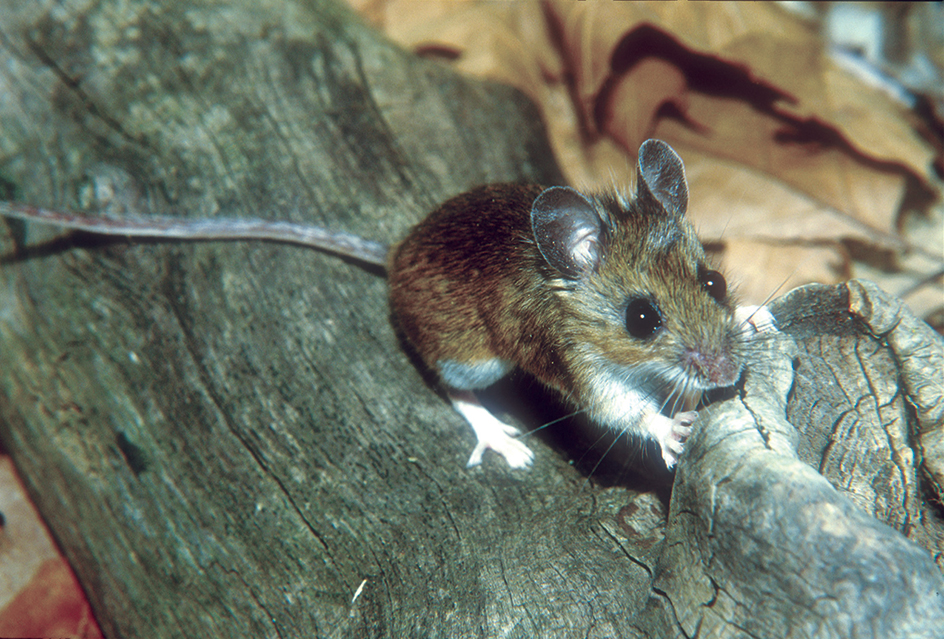
White-footed mice live from northern Canada and Alaska through Central America. They inhabit a wide variety of environments. Adults build their nests in tunnels that they dig themselves or in tunnels abandoned by other small mammals. They also nest in hollow logs, under tree stumps, and in the cracks of rocks. White-footed mice may go into homes to find such soft materials as paper, cloth, or cotton for their nests. They often build and use several nests a year. A female white-footed mouse usually bears two to seven young at a time. The young live in the nest for three to four weeks.
White-footed mice commonly sleep during the day and look for food at night. They eat mushrooms, berries, fruits, seeds, leaves, nuts, and insects. When excited or threatened, these mice thump their front feet rapidly on the ground. Such thumping may help attract mates or warn other mice of danger.
Harvest mice
also resemble house mice. They range from 2 to 6 inches (5 to 15 centimeters) long without the tail. American harvest mice occur from southwestern Canada to northern Ecuador. The Old World harvest mouse inhabits much of Europe and Asia.
Most harvest mice live in open grassy areas, though some prefer salt marshes or tropical forests. Many nest in places where tall grasses grow. They weave blades of grass into ball-shaped nests 21/2 to 7 inches (6 to 18 centimeters) in diameter. The mice may build their nests above ground on stems of grass or in the branches of a bush. They also may nest on the ground. A mother gives birth to three or four young at a time. The young reach maturity at 5 weeks of age.
Harvest mice eat primarily seeds. But their diet can also include mushrooms, green plant sprouts, and insects. The mice use plant stems as ladders to reach food and nests, wrapping their tails around the stems as they climb. They may gather seeds on the ground as well.
Field mice
grow 21/2 to 6 inches (6 to 15 centimeters) long without the tail. They rank among the most common mammals of Europe and Asia. Field mice inhabit not only grassy fields but also woodlands and forests. People refer to some of the woodland species as wood mice.
Field mice build grassy or leafy nests in tunnels that they dig underground. Females usually give birth to about six young at a time. The young mature at around 2 months. Like other mice, these rodents typically eat plants and insects. Their burrows contain stores of food for the winter.
Grasshopper mice
measure about twice as long as house mice, and they look stockier. They also have shorter, stubbier tails than do other kinds of mice. The fur ranges from brown to gray above and white on the belly. Grasshopper mice get their name because they eat mostly insects, including grasshoppers, crickets, flies, and beetles. They also will eat worms, scorpions, and seeds. When the mice can catch large numbers of insects, they store the food in a hiding place.
Grasshopper mice live in dry or desert regions of the western United States and northern Mexico. They often nest in the burrows and tunnels of prairie dogs, pocket gophers, and ground squirrels. Females usually give birth to three or four young at a time. Young mice become adults at about 2 months of age.
Grasshopper mice come out of their burrows at night to hunt. They catch prey much as cats do, creeping up to the victims and attacking quickly. To communicate with other grasshopper mice, they will stand up on their hind legs and give a high-pitched call.
Unusual mice.
Many kinds of mice have unusual characteristics that enable them to adapt to their environments. For example, the pygmy tree mice of tropical Southeast Asia possess grasping hands and feet for tree climbing. These mice spend much of their lives in trees. Adults build round nests in tree holes, and they eat mostly tree seeds and fruits. Pygmy tree mice also rank among the smallest mice, growing no more than 23/4 inches (7 centimeters) long without the tail.
Another group, the spiny mice, live mostly in dry regions of Africa and the Middle East. Coarse, spiny hairs cover the back and sometimes the tail of these rodents. Such spines probably help protect the mice against their numerous predators. People in many parts of the world keep spiny mice as pets.
Certain forest mice spend much of their time in the water. One group, the Central American water mice, live in tropical forests from southern Mexico to Panama. They feed mainly on aquatic insects and crustaceans, which they capture from streams. Like many other tropical species, these mice have become threatened with extinction because much of their habitat has been destroyed.
